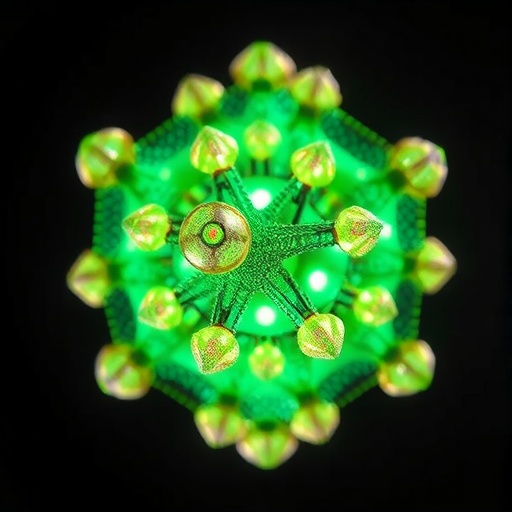In recent advancements in material science, researchers have been focused on the synthesis and application of nanocomposites, particularly in the field of electrochemical sensing and energy storage technologies. One significant study that has emerged in this realm involves the hydrothermal synthesis of cerium dioxide (CeO2) and reduced graphene oxide (rGO) nanocomposites. This innovative approach has sparked attention due to the enhanced properties these materials exhibit, which promise to revolutionize the way we perceive and utilize electrochemical sensors and supercapacitors.
The development of electrodes with superior electrochemical characteristics is crucial for applications in sensors and energy storage devices. The combination of cerium dioxide, a widely studied semiconductor oxide known for its catalytic properties, with the conductive nature of graphene, creates a unique synergy that enhances the overall performance of the resultant composite materials. In the context of modern technology, the ability to synthesize these components efficiently and effectively holds great promise for future applications.
The hydrothermal synthesis method, which involves the reaction of materials in aqueous solutions under high temperature and pressure, offers significant advantages over traditional synthesis techniques. This method not only allows for better control over the size, shape, and crystallinity of the nanoparticles but also facilitates the integration of rGO into the composite structure. The resulting CeO2/rGO nanocomposites exhibit remarkable electrical conductivity and increased surface area, both of which are critical factors influencing the performance of electrochemical devices.
The study conducted by Ramanjaneyulu and Narsaiah highlights the potential of these nanocomposites in various applications. Specifically, their research focuses on the role of CeO2/rGO in enhancing the sensitivity and efficiency of electrochemical sensors. By improving the charge transfer kinetics and providing a larger active surface area, these nanocomposites can detect even minimal concentrations of target analytes, making them invaluable in environmental monitoring, medical diagnostics, and chemical analysis.
Moreover, the supercapacitor performance of CeO2/rGO nanocomposites is another noteworthy aspect of the research. Supercapacitors, known for their ability to store and release energy rapidly, are crucial components in portable electronic devices, electric vehicles, and renewable energy systems. The unique electrochemical properties of CeO2, combined with the high conductivity of graphene, enable the nanocomposites to deliver high energy and power densities while maintaining a long cycle life. This dual functionality of sensing and energy storage significantly expands their applicability across various industries.
What makes this study particularly compelling is its emphasis on sustainable and efficient processes in nanomaterial synthesis. By prioritizing hydrothermal methods, the researchers align with the broader scientific movement towards green chemistry. This approach minimizes the usage of toxic solvents and reduces environmental impact, appealing to industries that are increasingly looking for sustainable solutions in material development.
As the demand for more versatile and reliable electrochemical devices continues to rise, the advancements reported in this study resonate well with current technological trends. The intersection of nanotechnology, material science, and electrochemistry opens avenues for the creation of smarter devices that can manage the complexities of modern applications. The synthesis of CeO2/rGO nanocomposites is a testament to the potential of combining different materials to produce superior functionalities.
The research also underlines the importance of collaborative efforts in advancing scientific knowledge. Interdisciplinary approaches, which bring together experts from various fields such as physics, chemistry, and engineering, are essential for addressing the challenges faced in developing next-generation materials and devices. By fostering collaboration and innovation, the scientific community can continue to push the boundaries of what’s possible in electrochemical sensing and energy technologies.
Looking forward, the implications of this research extend beyond the immediate applications of the nanocomposites. The fundamental principles derived from the study could pave the way for future explorations into other metal oxides and graphene-based materials, encouraging further innovation in electrochemical applications. As researchers continue to investigate the potential of various composite materials, the insights gained from this work will likely lead to the development of even more advanced and efficient systems.
In conclusion, the hydrothermally synthesized CeO2/rGO nanocomposites represent a significant leap forward in the field of electrochemical sensing and supercapacitor technologies. With their enhanced properties, these materials stand to benefit a wide range of applications, improving the performance of devices that play critical roles in society. As research progresses, it will be exciting to see how these findings translate into practical applications that could potentially change the way we interact with technology on a daily basis.
The journey of innovation in material science is ongoing, and studies like the one conducted by Ramanjaneyulu and Narsaiah highlight the importance of continued research and development. By exploring new materials and synthesis techniques, the scientific community not only addresses current technological challenges but also anticipates future needs. The pursuit of better-performing, environmentally friendly materials is the cornerstone of groundbreaking advancements that could enhance our quality of life.
The findings presented in this research serve as a reminder of the capabilities that lie within the intersection of diverse scientific disciplines. As we navigate the complexities of modern technology, the role of innovative materials such as CeO2/rGO nanocomposites will undoubtedly play a critical role in shaping a more efficient and sustainable future.
Subject of Research: Hydrothermal synthesis of CeO2 and CeO2/rGO nanocomposites for enhanced electrochemical sensing and supercapacitor applications.
Article Title: Hydrothermally Synthesized CeO2 and CeO2/rGO Nanocomposites for Enhanced Electrochemical Sensing and Supercapacitor Applications.
Article References:
Ramanjaneyulu, V., Narsaiah, T.B. Hydrothermally Synthesized CeO2 and CeO2/rGO Nanocomposites for Enhanced Electrochemical Sensing and Supercapacitor Applications. Ionics (2025). https://doi.org/10.1007/s11581-025-06543-3
Image Credits: AI Generated
DOI: https://doi.org/10.1007/s11581-025-06543-3
Keywords: Nanocomposites, Electrochemical Sensing, Supercapacitors, Cerium Dioxide, Reduced Graphene Oxide, Hydrothermal Synthesis.




